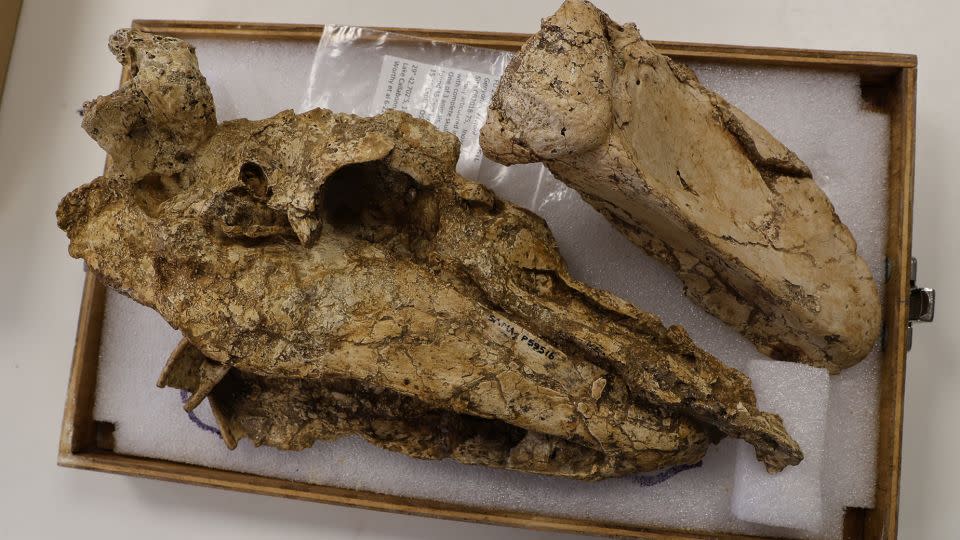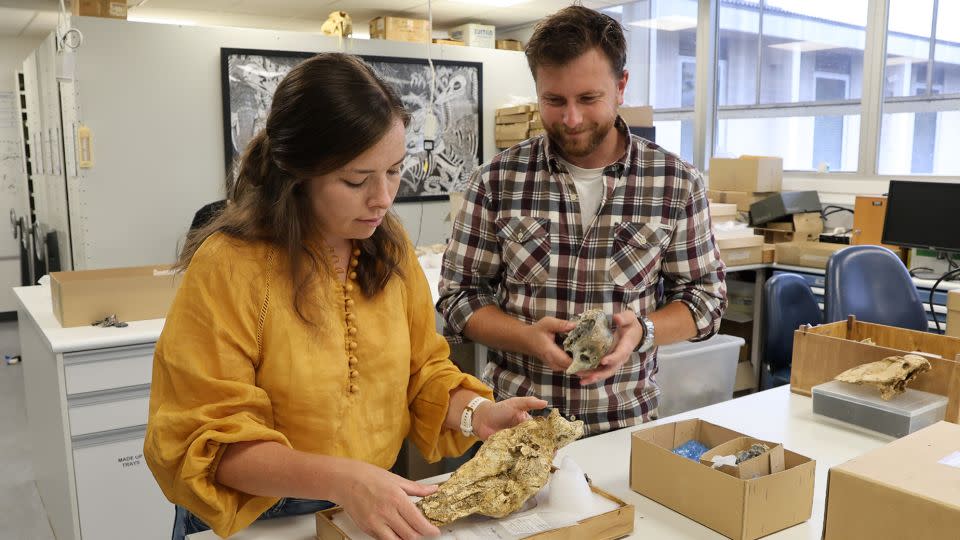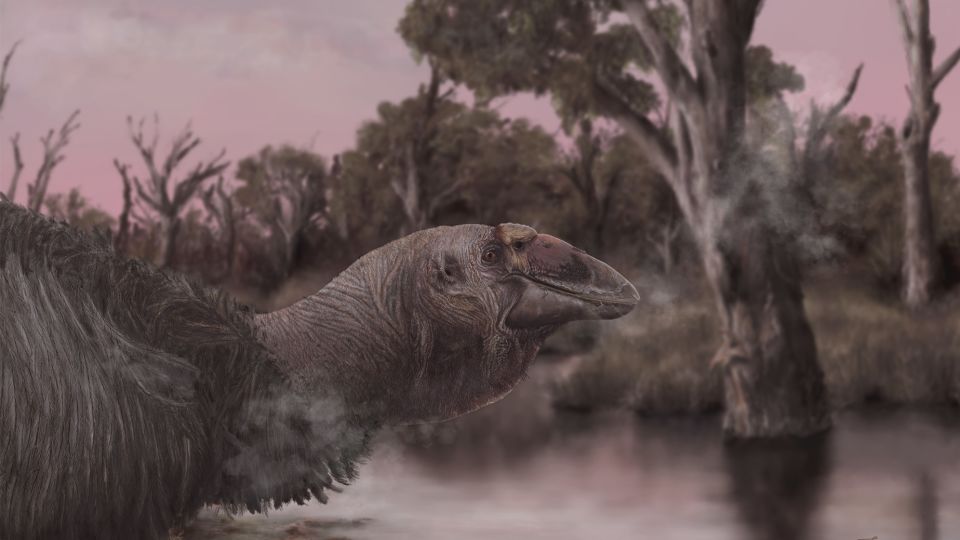Sign up for CNN’s Science of Miracles newsletter. Explore the universe with news of fascinating discoveries, scientific advances and more.
For more than a century, scientists have been searching without success for skull fossils of the thunderbird species Genyornis newtoni. About 50,000 years ago, these titans, also known as mihirungs, from an Aboriginal term for “giant bird”, stomped through the forests and grasslands of Australia on muscular legs. They stood taller than humans and weighed hundreds of kilograms.
The last Mihirungs became extinct about 45,000 years ago. The single skull, found in 1913, was incomplete and badly damaged, raising questions about the giant bird’s face, habits and ancestry.
Now, the discovery of a complete G. newtoni skull has solved this long-standing mystery, giving scientists their first face-to-face encounter with the massive mihirung.
And it has the face of a very strange goose.

G. Newton was about 2 meters tall and weighed up to 529 pounds (240 kilograms). It belonged to the family Dromornithidae, a group of flightless birds known from fossils found in Australia.
Between 2013 and 2019, a team of paleontologists discovered a first-ever G. newtoni fossil at South Australia’s Lake Callabonna, revealing multiple skull fragments, a skeleton and an articulated skull that provide the first evidence of the bird’s upper bill. . This wealth shed new light not only on G. newtoni but also on the entire dromornithid group, linking it to modern waterfowl such as ducks, swans and geese, the scientists reported Monday in the journal Historical Biology.
Although scientists have known about Genyornis for more than a century, the new fossils and reconstruction provide critical details that were missing, said Larry Witmer, a professor of anatomy and paleontology at Ohio University, who was not involved in the research.
“The skull is always the prize simply because so much important information is in the head,” Witmer said in an email. “It’s where the brain and sense organs are, it’s where the feeding apparatus is, and it’s usually where the show organs are (horns, crests, bands and combs, etc.),” he said. “Additionally, the skulls tend to display structural features that give us clues to their genealogy.”
In the new study, “the authors milked these new fossils for everything they had,” Witmer said. The researchers not only modeled the bones in the skull; They also analyzed the placement of jaw muscles, ligaments and other soft tissues that provide clues to the bird’s biology.
“This latest discovery of new Genyornis skulls has really helped fill in the gaps,” Witmer said.
‘much like you did’
The newly found skull takes center stage in a digital reconstruction, supplemented by other skull fossils and data from modern birds, and provides previously unknown clues about what G. newtoni looked like, said lead study author Phoebe McInerney, a vertebrate paleontologist and researcher at Flinders University in South Australia.
“Only now, 128 years after its discovery, can we say what it really looked like,” McInerney said in an email. “Genyornis has a very unusual beak, which is shaped very much like a goose.”
Compared to the skulls of most other birds, the skull of G. newtoni is quite short. But the jaws are massive, supported by powerful muscles.
“They would have a very wide gap,” McInerney said.
Kafka also hinted at G. Newton’s diet. A flat gripping area on the beak was suitable for tearing soft fruit and tender shoots and leaves, and a flattened palate on the underside of the upper carton could have been used to crush fruit into a pulp.
“We knew from other evidence that they probably ate soft food, and the new beak supported that,” McInerney said. “The skull also showed some evidence of adaptations for feeding in water, possibly on freshwater plants.”
This suggestion of underwater food is unexpected, given the massive size of G. newtoni, Witmer said.
“Perhaps this shouldn’t be too surprising given that dromornithids like Genyornis are related to the group including ducks and geese, but Genyornis was six or seven feet long and weighed perhaps up to 500 pounds,” Witmer said. Other fossil discoveries may help resolve whether these adaptations were unused traits inherited from aquatic ancestors, “or whether these giant birds were diving into the shallows in search of tender plants and leaves.”
‘A strange union’
The reconstruction helped scientists resolve the conflicting lineage of dromornithids, placing them within the waterfowl order Anseriformes, the study authors reported. Based on the bone structures and associated muscles, dromornithids were likely closely related to the ancestors of modern South American shrikes, duck-like birds that inhabited wetlands in South America.


While G. Newton had a goose-like beak, its face did not match that of modern geese, said study co-author and avian paleontologist Jacob Blokland. A researcher with the Flinders Paleontology Group at Flinders University, Blokland illustrated reconstructions of the skull and of G. Newton in life.
“I was surprised by how superficially strange it looked, with its large bill, but definitely unlike any goose we have today,” Blokland said in an email. “There are aspects reminiscent of parrots, to which it is not closely related, but also of ground birds, which are much more closely related. In some ways it seems like a strange confluence of very different-looking birds.”
For the new reconstruction, Blokland started with the bony region of the outer ear, “since there were several specimens that preserved this part,” he said. From there, he built a scaffold that was stable across the many skull fossils. Some areas of the reconstruction were based on skulls belonging to other dromornithids or modern waterfowl, and anatomical studies of modern birds hinted at how muscles and ligaments might move bones.
A previously unknown detail was a broad, triangular bony shield called a casque on the top, which may have been used for sexual displays, the study authors reported.


Emus and large, flightless cassowaries (which are not close relatives of thunderbirds) currently roam Australia, but cast a much smaller shadow than the long-lost mihirungs, which still loom large in the popular imagination , McInerney said. There is much about the anatomy of these extinct giants that has yet to be discovered, she added, such as how inner ear structures associated with head stabilization and locomotion may have been affected by gigantism and the lack of flight.
And while the new perspective on G. newtoni is the most accurate to date, the additional fossils will bring into sharper focus the portrait of this unusual giant goose — the last of the mighty thunderbirds — and its extinct habitat, Blockland said. .
“Such a giant and unique bird obviously affected the environment and the other animals it interacted with – big or small,” he said. “Only through study can we build a bigger picture and discover what we are missing now.”
Mindy Weisberger is a science writer and media producer whose work has appeared in Live Science magazine, Scientific American, and How It Works.
For more CNN news and newsletters, create an account at CNN.com
